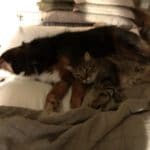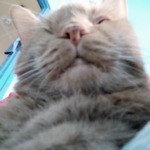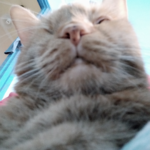Hello,
I think that it perfectly acceptable to go back to your vet and express your concerns. I also think it is completely inappropriate to not have offered loads of options, everything from medications to inhalers, to humidifiers your supplements to referral in this case. I also think that all vets should be willing to do a sedated oral cavity exploratory exam to look for a polyp. But that’s just me and lots of vets think I am too generous with my patients and clients. So maybe you should talk to your vet and ask friends family and all local cat people for a referral to someone who will give your more help and meaningful treatment options. Let me know what happens. Good luck!
Hello! I rescued a stray domestic shorthair that came crying at my door about 6 months ago and named him Koda. He is the sweetest boy of about 5 years (not too sure about his age though) and I am so grateful of the love he has shown me. Since I’ve had him, there has been nasal discharge on one side of his nose. He began sneezing after a while and I noticed large chunks of hardened mucus would come out. I took him to the vet and he was put on antibiotics and they cleared out most of the build up. The vet also did an x ray and it showed that one side of his sinuses were completely backed up with mucus, so he did a blind bioscopy to look for polyps and could not find anything. The antibiotics seemed to work at the time, but now looking back I’m assuming it was because the they had cleared out most of the mucus, because the symptoms came back after about a week after stopping antibiotics. We are now looking at constant snoring sounds, occasionally gasping for air, sneezing and decreased appetite due to not being able to smell his food. The vet recommended us to someone that had the proper technology, which would be a scope and a ct scan to go in and look for any polyps, and remove them if found. This would cost me $1500-$3000 which I cannot afford since I am a college student 🙂 I went anyways to get their opinion and stupidly spent about $1000 on more testing, appetite stimulants, and more antibiotics that didn’t work. I am considering trying steroids to try and lessen the symptoms just so that he can have an easier time breathing if they worked, but I am afraid of the cost and especially the side effects, if it it doesn’t help that will be more wasted money. Recently, the nasal discharge has spread to the other nostril and he has more bloody mucus than ever before, and as of three days ago, a mucus-like mass has protruded from one nostril and has slowly turned black and bloody over these few days. I tried to remove it but it was very stuck and started bleeding, and I could tell the poor baby was in pain. It may be a polyp that has slowly moved out of his nose, so I will be calling a vet tomorrow to hopefully get it taken out.
I am looking for another opinion on what might be going on or of any similar stories. If anyone knows any good vets in the Tampa, Florida area I would be forever grateful. I am willing to take Koda anywhere in Florida if it means I can find help for less money or just more straightforward people who care about animals and not just the money! Koda is still a happy and loving cat but he has slowly become less playful, and I can tell he does not feel his best becsause of all of this. I am afraid of how much worse it can get. Thank you so much for any help in advance!
Comments
My 6-year-old cat has recently had some trouble breathing. She gets a deep sounding snore when breathing in and can’t seem to take a complete breath. The snoring only seems to occur when she is breathing in, and not out. The snoring does sometimes stop. This mainly happens when she is sleeping, her breaths are softer and she seems to be able to breath better. I have also noticed that when I hold her mouth open a little bit, she is able to breathe in and out without any problem. She occasionally has sneezing fits, but they are very rare to see. There is no discharge from her nose, eyes, or ears. She actually has a very dry nose. I have also noticed that she has been eating less than before, but she is still able to eat and drink water. We took her to a vet, but they told us they would only be able to diagnose her with an endoscopy, which they said would cost us around $1,300. I’ve looked online for symptoms similar to hers and cats that had similar breathing patterns/sounds. The closest thing I have been able to find is something called a “nasopharyngeal polyp”. I’m a little lost on what to do. Should I continue with the first vet, and get a concrete diagnosis? or get a second opinion and maybe bring up what I found while researching online? The cost of the first vet is kind of high for me as I’m a college student, but If it is what my cat needs to be able to breathe comfortably again I’ll pay it.
Comments
Hi there,
I guess it will be long.
Anamnesis
My cat is an adopted cat from shelter. He was 1.5 yrs old when I adopted him and 9 months old when he got into the shelter. He is 7.5 yrs old now.
He suffered from catflu. He lost his left eye because of it. He had polyp in his left nasal cavity having spread to his left earcanal also, so he had to undergo a surgery at the age of 1.5.
The problem
Every season changes– fall, spring — makes him sneeze so I always administer him Vetri-DMG and Flumax to strenght his immune system.
This fall he was sneezing a lot sounded some discharge up, but didn’t see anything then he started snoring didn’t matter if he was sleeping or awaken. He vomited brownish, greenish, and yellowish fluid. Later on he tried to vomit, but nothing came up. On the top of these he seemed to be gasping for breath or being out of breath.
Since having administered Vetri-DMG and Flumax for 3 or 4 weeks I took him to a vet. He administered him eyedrops (3×2 for 7-10 days) Tobradex — corticosteroid and antibiotics — as he found nothing, but his teary eye and conjunctivitis, which is of course tearing all the time as he has epiphora thanks to catflu. He also administered Moxiclear spot on when the next deworming time comes (he is given dewormer each month, Fenbendazole and Praziquantel — guess you know it as Panacur) to make sure that he has no heartworm or lungworm…
Eardrops have been used for 8 days and he has started snoring again. He snores sometimes even he is awaken when breathing in or out.
QUESTION
His RIGHT side nostril seems to be swollen inside, so as far as I can see ti and narrower on this side. And that’s what makes me be so worried. I am afraid of… nasal cancer. He is a ginger cat and has lentigo on his nose, in on his lips, on his pows… How can I find out what the problem is? Unfortunately, in my country vets doesn’t know anything except giving injections… If an illness is not well-seen yet they do nothing.
Help us please!
Thank you so much in advance!
Comments
I have the sweetest Siamese mix, Goldie, adopted from our local humane society. Unfortunately, she has been a sick kitty and she’s had 4 URIs in her two years of life. She did take the full course of antibiotics for all of them and healed successfully.
Recently, she’s been making low snoring noises periodically when awake and sleeping and it seems to be only when inhaling. She’s a talkative girl and sometimes her voice changes when meowing. She has no other symptoms and is eating, drinking and playing normally and there has been no mouth breathing while making the noises. Her breathing rate has been normal. Sometimes it seems like she is making the noises and then stretches out real long in the first picture to get comfortable.
Below is a link to her video around 24 seconds you can hear it, you might have to put it at full volume:
If this is difficult to hear it sounds very similar to this:
I have a vet appointment next week and am concerned she has stertor from an oropharyngeal polyp from my online research and her symptoms. Is this something that a vet would be able to see without putting them under sedation? Are there any other suggestions you have as to what I could have them test for if it’s not a polyp? I wasn’t sure if she could have asthma or another breathing related issue.
Finally, do you by chance have any recommendations for vets in Phoenix, Arizona? I am just getting myself prepared if needed for a second opinion or if surgery is necessary.
Appreciate it and all your tips and videos online! You are doing incredible work!
Comments
Hey! Just found your page from YouTube, was wondering if it’d be possible to chat about my cat? Almost certain he has a nasopharyngeal polyp but I am having trouble convincing any vets in the Dallas area to sedate him and take a look without him first getting scans and tests that cost thousands of dollars. Is there anything I should be asking them for differently? He’s been fighting a URI for about 5 months now and we have done six rounds of antibiotics with steroids and antihistamines to help and nothing has stopped his symptoms from returning and we have only now made the connection as to why that is. He has the distinct snore noise while breathing and every other listed symptom associated, I just can’t afford the tests the vets are saying they require, it’s very heart breaking. Any help or wisdom is appreciated, we just don’t have the money to do much else and he is degrading quickly since his last round of antibiotics ended this week. I wish I didn’t sound so sure, we just are panicking that we have wasted so much time and money and may have missed our chance to best this this while we could and now may be unable to. Just heart breaking all around.
Comments
After many attempts to resolve one of my foster kitten’s URI, I learned about nasopharyngeal polyps and low and behold that was the problem with Lindy. My vet’s team removed the bulk of the polyp behind Lindy’s soft palate with a CO2 laser rather than with traction using forceps, the doctor estimated she removed 90%. I see you have had much experience with these nasty growths. Lindy is a foster and I am getting ready to turn her over to the adoption center to find her forever home. I’m not exactly sure what to write about Lindy’s polyp and what might happen in the future. I hear they can recur. Do you have any advice to give me. Thanks so much.
Comments
A repeat rhinoscopy on my 11 year old cat revealed new tissue growth in the nasopharyngeal space with a very small polyp that has not changed in size since last year. The new tissue growth and polyp was biopsied again (last year it was negative) for cancer which is what the vet suspects. Her labs are all normal. I will have a definitive diagnosis in 3-5 days. If it comes back negative again, it would be highly indicative of Nasopharyngeal Stenosis according to the vet. Has anyone out there had any experiences with this possible diagnosis? In the meantime my kitty continues to have very noisy and difficulty breathing with trouble swallowing her food. The nasopharyngeal flush did nothing to improve her symptoms this. I am doing my best to keep her calm and adding water to her pate food to assist with eating as she still has a very good appetite. Any help would be greatly appreciated.
Comments
My 11 year old cat was diagnosed with a nasopharyngeal polyp via CT scan and rhinoscopy last year. A biopsy was taken and found not to be cancerous. A nasal flush was the only intervention taken (which improved her symptoms) as I was told it was too small to remove. 3 weeks ago she was taken back with the same symptoms (noisy and difficulty breathing, quacking noises, and problems swallowing food) and another nasal flush was done under anesthesia and an antibiotic injection given with steroids also. Since then she has gotten progressively worse in her symptoms. The same vet wants to do another rhinoscopy and flush and cannot guarantee any results. I am not a rich person and so far between last year and now I have spent over $4,000 to help her. I was hoping you or someone in the Brooklyn area can recommend a reputable veterinarian for at least a second opinion as I am beginning to feel that I am being taken advantage of monetarily because of my dedication to getting help for my cat. Any help or advice would be greatly appreciated.
Comments
My 14 year old cat is having trouble breathing. After seeing her vet, we suspect she has a polyp. The examination was brief and the vet suggested X-rays or better yet, an MRI ($2,000).
I am a teacher and am on a very tight budget. What I would like to know is what kind of tests/examination should be required for the vet to complete the diagnosis? It seems from your youtube video (https://www.youtube.com/watch?v=RCRwkQXd3Qs), that the vet could have found this by examining the inside of the cat’s mouth.
I’m trying to keep my costs down. How do I approach my vet regarding this matter?
Thanks
Al











Hello,
Thank you for saving this kitty. In some cases these guys are chronic upper respiratory kitties, or herpes, or a few other harder to treat things. I would talk about a nasal flush and long term lysine and even rotating antibiotics. See if there is a feline specialist near you. And be honest about your budget. See if they can help. I wish you the best of luck!